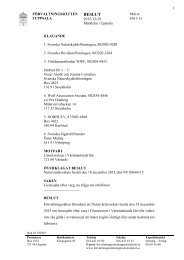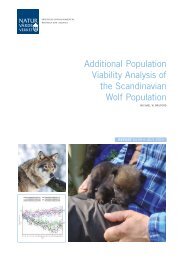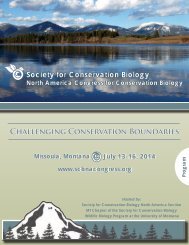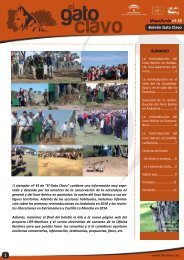1oC3Dbk
1oC3Dbk
1oC3Dbk
You also want an ePaper? Increase the reach of your titles
YUMPU automatically turns print PDFs into web optimized ePapers that Google loves.
(anteaters, sloths and armadillos) and their habitats. Our active<br />
group of committed specialists currently consists of 21<br />
members from eight countries. In 2013 we increased the<br />
number of captive care specialists to strengthen the ex-situ<br />
component of Xenarthra conservation. We have also<br />
incorporated two specialists working with the Critically<br />
Endangered pygmy sloth (Bradypus pygmaeus), one of our<br />
priority species.<br />
This year we have re-assessed the conservation status of<br />
all 31 species of Xenarthra for the 2015 Global Mammal<br />
Reassessment. Although we are still working on this update,<br />
we anticipate that the majority of species will remain in the<br />
same threat category, with the exception of Dasypus pilosus<br />
that should be recategorized from Vulnerable to Data Deficient<br />
due to the lack of information on this species, and of Dasypus<br />
sabanicola that should be changed from Least Concern to<br />
Near Threatened based on new information.<br />
In coordination with the SSC office and the Director<br />
General of IUCN, our Specialist Group has intervened to halt<br />
plans for exporting pygmy sloths for a captive breeding<br />
program, because of the impact of removing animals from the<br />
extremely small wild population on the island of Escudo de<br />
Veraguas, Panama. Furthermore, our Specialist Group has<br />
played a fundamental role in setting up an independent<br />
advisory committee for the conservation of this charismatic<br />
species and for including the species in CITES Appendix II.<br />
One of our Vulnerable species, the Brazilian three-banded<br />
armadillo (Tolypeutes tricinctus), will be the official mascot of<br />
the 2014 FIFA World Cup, which will take place in Brazil. Our<br />
Specialist Group has teamed up with the Brazilian NGO<br />
Associação Caatinga to increase awareness for the<br />
conservation problems of three-banded armadillos and<br />
coordinate the scientific projects aimed at the long-term<br />
conservation of this wonderful species.<br />
We have continued raising public awareness for xenarthrans<br />
and their conservation problems through regular updates of our<br />
Facebook page and our website www.xenarthrans.org, which is<br />
available in English, Spanish and Portuguese. Our peerreviewed<br />
Newsletter Edentata is increasingly being recognized<br />
as an important means to publish conservation-relevant data on<br />
xenarthrans. Our Specialist Group has also provided scientific<br />
advice to conservationists, governments, and other interested<br />
groups, and has assisted other Specialist Groups with their Red<br />
List assessments.<br />
Finally, in April 2013, in collaboration with Green Heritage<br />
Fund Suriname, we organized the Second International Sloth<br />
Meeting and held a course on xenarthrans in Suriname. These<br />
events allowed us to interact with many people committed to<br />
the conservation of sloths and motivate many students to<br />
initiate studies on xenarthrans.<br />
We wish to thank Conservation International, the San<br />
Antonio Zoological Society, and the Greater Sac AAZK<br />
(American Association of Zoo Keepers) Chapter – Sacramento,<br />
CA for their generous financial support.<br />
Dr Mariella Superina<br />
Chair, Anteater, Sloth and Armadillo Specialist Group<br />
Antelope Specialist Group<br />
The mission of the Antelope Specialist Group (ASG) is to<br />
conserve the world’s antelope diversity. There is an ongoing<br />
review and update of status summaries and threat<br />
assessments for all threatened antelopes.<br />
A number of events were facilitated by the ASG, including a<br />
Western Giant Eland conservation strategy workshop in Saly<br />
Portudal, Senegal, 28–31 January 2013; the restoration of<br />
Goitered Gazelle to the Caucasus, Baku Azerbaijan, 2–6 April<br />
2013; a Mountain Bongo conservation workshop in Dubai,<br />
UAE on May 2013; a CMS Saiga Antelope technical workshop<br />
in Astana, Kazakhstan on 18 June 2013, and a Dama Gazelle<br />
conservation workshop in Edinburgh, UK, 19–21 November<br />
2013.<br />
We attended a number of high profile meetings including<br />
the ‘16th session of the Conference of the Parties’ (CoP16)<br />
of CITES in Bangkok, Thailand, 3–14 March 2013; the ‘13th<br />
annual meeting of the Sahelo-Saharan Interest Group’ (SSIG)<br />
in Agadir, Morocco, 2–3 May 2013, and the ‘EAZA Antelope<br />
and Giraffe TAG’ meeting in Edinburgh, UK, 27–28 September<br />
2013.<br />
In September 2013, we advised the Forestry and Wildlife<br />
Department in Eritrea, Asmara on Antelope priorities and<br />
planning.<br />
In 2013, ASG received a grant for the ‘Dama Gazelle<br />
Workshop’; from the USFWS ‘Ranching for Restoration’<br />
programme managed by the US based NGO, Conservation<br />
Force.<br />
The latest issue of our newsletter Gnusletter (Volume 31<br />
Number 1 May 2013) is available here.<br />
Dr Philippe Chardonnet and Dr David Mallon<br />
Co-chairs, Antelope Specialist Group<br />
Brazilian Three-banded Armadillo (Tolypeutes tricinctus). © Adriana<br />
Bocchiglieri<br />
More than 100 Giant Elands in a hunting block in northern Cameroon.<br />
© Jean-Paul Arabeyre<br />
30 IUCN species Annual Report 2013






